Celestron EdgeHD: versatile telescope, many applications
Celestron EdgeHD telescopes are the evolution of classic Schmidt-Cassegrains: not only they can be used in visual (unlike the SC, they are perfect also with very large apparent field of view eyepieces) and for planetary and lunar photography but, thanks to dedicated focal reducers, they are great instruments for long-exposure astrophotography. In this article we will see how to use them for this application and what are the advantages compared to other optical schemes often used by amateur astronomers like the classic Schmidt-Cassegrains or Ritchey-Chretiens.
Celestron is famous worldwide for its line of Schmidt-Cassegrain telescopes that, since the 70s of the twentieth century really changed the world of amateur astronomy. But with the advent in recent years of wide-angle eyepieces and digital cameras (DSLR or CCD cameras) with large sensors (for example 23x15mm or 36x24mm) the optimal correction on axis of SC telescopes was not enough and Celestron has faced the challenge of creating a more advanced optical design, also for digital astrophotography. By inserting a special corrector inside the optical tube, Celestron developed a special aplanatic optical scheme, combining the advantages of the Corrected Dall-Kirkham (CDK) telescopes to those of the Schmidt-Cassegrain ones. By adding different mechanical improvements (such as the new internal baffles and a new design for a greater illuminated field, the new primary mirror support with locking knobs to further reduce mirror shift and ventilation ports with filter to reduce mirror acclimatization time avoiding dust entering the tube), created the new Celestron EdgeHD line, modern telescopes with high-performance, universal, easy to use but also cost effective.

Unlike other optical designs optimized for a particular application, Celestron EdgeHD have the advantage of being really versatile telescopes and they can therefore be used with great results for many different applications:
- Visual use: high optical quality combined with large flat field makes them perfect for visual use also with large apparent field of view eyepieces: stars will be point across the whole field, really better than classic Schmidt-Cassegrain telescopes. Compared to Ritchey-Chretien telescopes, Celestron EdgeHD telescopes offer a greater contrast thanks to lower obstruction.
- Lunar and planetary astrophotography: high optical quality of the optics along with high focal length and not too high obstruction (less compared to Ritchey-Chretien telescopes), make the Celestron EdgeHD also excellent for lunar planetary imaging with DSLR and dedicated planetary camera. In order to obtain high magnifications just insert in the visual back, before the camera, a Barlow lens (usually with magnification factor between 2x and 4x) to obtain even higher magnifications, and then record the finer details.
- Deep-sky long exposure imaging astrophotography: the dedicated 0.7x reducer/corrector (which reduce the focal ratio from f/10 to f/7), which is available for 8″, 11″ and 14″ models, is designed to keep a large corrected field (it’s perfect also for APS-C type sensors with 27mm diagonal). The secondary mirror of Celestron telescopes EdgeHD is supported by the corrector plate that not only closes the telescope (protecting more the internal optical elements) but also prevents the creation of diffraction spikes seen as crosses on bright stars, instead generated by Ritchey-Chretien telescopes because of large secondary mirror supports.
Now we analyze in detail how to use Celestron EdgeHD telescopes for deep-sky astrophotography by taking, as an example, the most compact model (EdgeHD 800) that offers high performance at an affordable price. The compact and lightweight design makes it perfect for those looking for an astrophotography telescope easy to use even on not particularly large and expensive mounts. We also perform a real performance comparison (photographic test) with one of the most used Ritchey-Chretien telescope (produced by Taiwanese GSO), one of the optical designs tested by Celestron during EdgeHD design but discarded because, as they reported, in order to obtain excellent resuIts, it would lead to a too high cost.
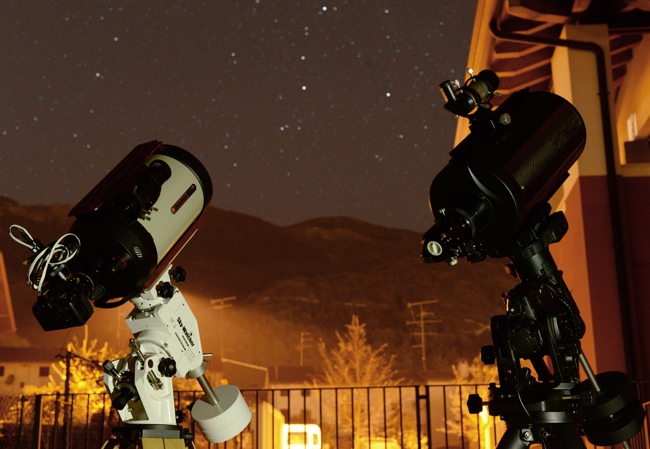
Analyzing the spot diagram we can see how the EdgeHD 800 focuses, at different distances (radius) from the optical center, the different wavelengths (red, green and blue) of star light. Celestron EdgeHD 800 offers very well corrected stars even for a 14mm radius from the center corresponding to an image circle of 28mm, greater than APS-C sensors used by many DSLR cameras.
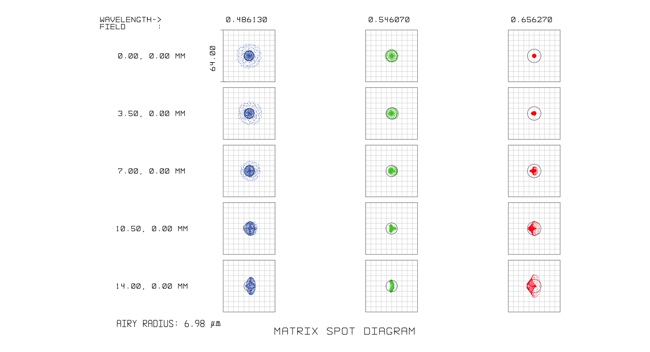
Moreover, unlike other optical designs and telescopes from other brands, Celestron EdgeHD have dedicated focal reducers (4 elements for EdgeHD 800 reducer, 5 elements for EdgeHD 1100 and 1400 reducers) designed for both a wide corrected field and a long back focus (optimum distance between focal reducer and camera sensor) that lets you insert also other accessories (such as off-axis guiders, filter wheels or adaptive optics) between the camera and focal reducer. In order to have best performance, after removing the visual back and connecting the Celestron EdgeHD 800 focal reducer directly to the rear thread in the back of the telescope, we must position the camera sensor at a distance of 105mm relative to the rear thread of the focal reducer.
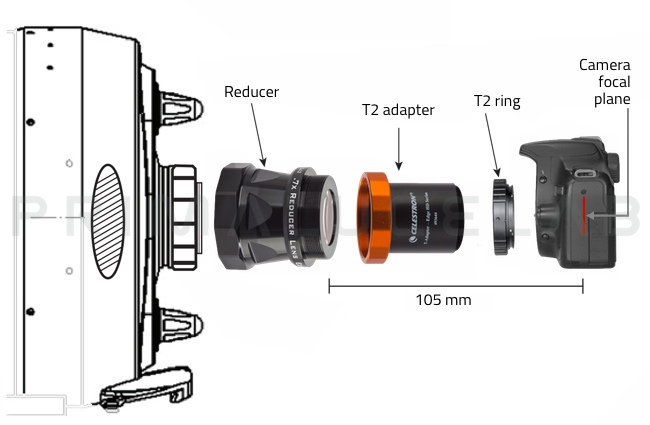
In order to compare their performance we recorded several test pictures comparing the EdgeHD 800 203mm f/10 (with or without focal reducer) with the RC 8″ GSO 200mm f/8 (with and without flattener), all installed on the same mount and imaging with a Nikon D610 DSLR camera with Full Frame size sensor (36x24mm size, 43mm diagonal). The images (20 seconds exposition each @ 6400 ISO) below show also the magnification of an area of the sensor corresponding to the edge of a typical APS-C sized sensor to highlight the field correction.
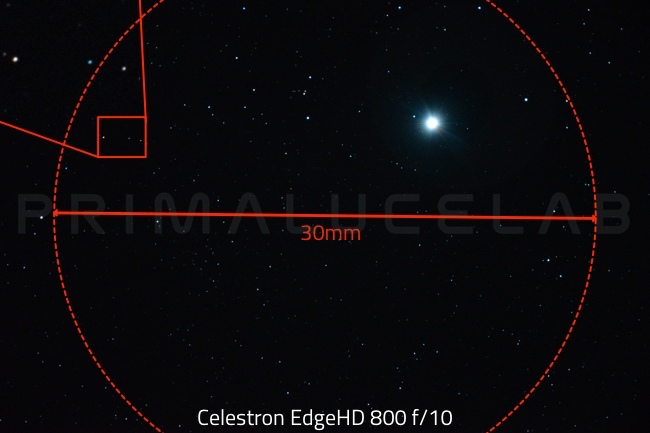
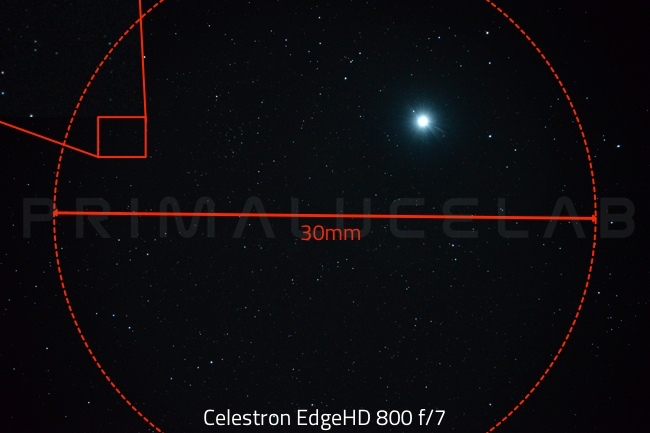


As you can see from the images above, the performance of Celestron EdgeHD 800 are very similar compared to those of GSO RC 8 equipped with flattener, making both an excellent choice for those who want to perform deep-sky astrophotography. However, we noted few differences:
– Celestron EdgeHD 800, thanks to the dedicated focal reducer, provides corrected images even at f/7, and with much larger sensors. The focal reducer generates point stars and perfectly corrects APS-C sensor, but you can also use larger Full Frame sensors.
– the GSO RC 8 generates the typical diffraction spikes, visible in the image as a cross around the star Capella. This is an effect you may like or not but you can not delete. The GSO also showed a field correction is not perfectly symmetrical, a sign that the focuser was not perfectly centered with the optical axis. This telescope is in fact much more difficult to collimate than the Celestron EdgeHD (that you can collimate in a few minutes).
Then we compared the performance of two telescopes in high resolution planetary imaging using a QHYCCD 185C color camera and the same apochromatic 3xBarlow lens (by adjusting slightly image scale for the Barlow in order to obtain the same magnifications in the two telescopes because of their different focal lengths). After noted that the mirror shift in the EdgeHD 800 was almost invisible, is really lower than classic Schmidt-Cassegrain telescopes, we recorded two videos with the same number of images and we processed in the same way with Registax and PixInsight (avoiding that processing could modify results). We report the processing results in the below image: in the upper row the result of average 200 images (with Registax), in the row below with a slight processing (unsharp mask with PixInsight). Note: unfortunately, the night had no a good seeing and Jupiter was only 20 degrees on the horizon but the results are indicative of the performance of the two telescopes.
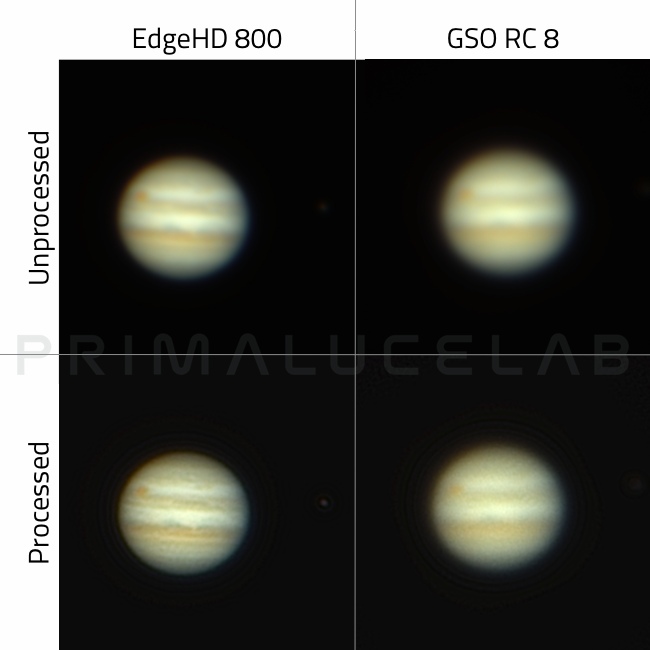
Here you can immediately see that the Celestron EdgeHD 800, thanks to lower obstruction, generates much better images. We note here that obstruction of the EdgeHD 800 is 34% while the one of GSO RC 8 is 44%.
Conclusions:
EdgeHD 800 telescope proved to be a real high quality all-around instrument that perfectly works both for long exposure astrophotography (great with the 0.7x focal reducer) and for high magnification planetary imaging. The EdgeHD is really a versatile telescope we can recommend also to amateur astronomers that already have an apochromatic refractor (with lower focal length). The EdgeHD is in fact complementary to refractors and it excels precisely where apochromatic refractors (that are perfect for view field long-exposure astrophotography) show their limits: namely in long exposure imaging of smaller dimensions deep-sky objects and planetary/lunar photography at high magnification, without disdain occasionally some nice observations!
